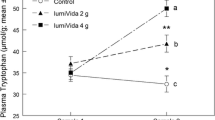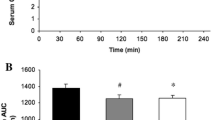Summary
Brain serotonin (5-hydroxytryptamine, 5-HT) has been suggested to be involved in central fatigue during prolonged exercise. Changes in the ratio of plasma free tryptophan (free Trp) to branched-chain amino acids (BCAA) are associated with altered brain 5-HT synthesis. The purposes of this study were to describe systematically the effects of prolonged exercise on changes in plasma free Trp and BCAA and to examine the effects of carbohydrate (CHO) feedings on these same variables. Eight well-trained men [\(\dot V{\text{O}}_{\text{2}} \) max = 57.8 (SE 4.1) ml kg−1 min−1] cycled for up to 255 min at a power output corresponding toVO2 at lactate threshold (approximately 68%VO2max) on three occasions separated by at least 1 week. Subjects drank 5 ml kg−1 body wt−1 of either a water placebo, or a liquid beverage containing a moderate (6% CHO) or high (12% CHO) concentration of carbohydrate beginning at min 14 of exercise and every 30 min thereafter. Exercise time to fatigue was shorter in subjects receiving placebo [190 (SE 4) min] as compared to 6% CHO [235 (SE 10) min] and 12% CHO [234 (SE 9) min] (P<0.05). Glucose and insulin decreased in the placebo group, and free Trp, free-Trp/BCAA, and free fatty acids increased approximately five- to sevenfold (P < 0.05). These changes were attenuated in a dose-related manner by the carbohydrate drinks. Plasma free Trp and plasma free fatty acids were highly correlated (r=0.86,P<0.001). Plasma BCAA did not change in the placebo group, but decreased slightly in those receiving 6% CHO and 12% CHO (P<0.05). No differences in heart rate,\(\dot V{\text{O}}_{\text{2}} \), plasma volume and respiratory exchange ratio were found. The results indicate that free Trp and free Trp/BCAA increase progressively during prolonged cycling to fatigue. This response was attenuated by CHO feedings. Changes in plasma free fatty acids probably play a prominent role in these responses.
Similar content being viewed by others
References
Bailey SP, Davis JM, Ahlborn EA (1992) Effect of increased brain serotonergic activity on endurance performance in the rat. Acta Physiol Scand 145:75–76
Blomstrand E, Celsing F, Newsholme EA (1988) Changes in plasma concentrations of aromatic and branch-chain amino acids during sustained exercise in man and their possible role in fatigue. Acta Physiol Scand 133:115–121
Blomstrand E, Perrett D, Parry-Billings M, Newsholme EA (1989) Effect of sustained exercise on plasma amino acid concentrations and on 5-hydroxytryptamine metabolism in six different brain regions in the rat. Acta Physiol Scand 136:473–481
Blomstrand E, Hassmen P, Ekblom B, Newsholme EA (1991a) Administration of branched-chain amino acids during sustained exercise — effects on performance and on plasma concentrations of some amino acids. Eur J Appl Physiol 63:83–88
Blomstrand E, Hassmen P, Newsholme EA (1991b) Effect of branched-chain amino acid supplementation on mental performance. Acta Physiol Scand 143:225–226
Bloxam DL, Hutson PH, Curzon G (1977) A simple apparatus for ultrafiltration of small volumes: application to the measurement of free and albumin-bound tryptophan in plasma. Anal Biochem 83:130–142
Bloxam DL, Tricklebank MD, Patel AJ, Curzon G (1980) Effects of albumin, amino acids, and clofibrate on the uptake of tryptophan by the rat brain. J Neurochem 34:43–49
Chaouloff F (1989) Physical exercise and brain monoamines: a review. Acta Physiol Scand 137:1–13
Chaouloff F, Kennet GA, Serrurrier B, Merino D, Curzon G (1986) Amino acid analysis demonstrates that increased plasma free tryptophan causes the increase of brain tryptophan during exercise in the rat. J Neurochem 46:1647–1650
Chaouloff F, Laude D, Merino D, Serrurrier B, Guezennec Y, Elghozi JL (1987) Amphetamine and alpha-methyl-para-tyrosine affect of exercise-induced imbalance between the availability of tryptophan and synthesis of serotonin in the brain of the rat. Neuropharmacology 26:1099–1106
Coggan AR, Coyle EF (1987) Reversal of fatigue during prolonged exercise by carbohydrate infusion or ingestion. J Appl Physiol 63:2388–2395
Coggan AR, Coyle EF (1988) Effect of carbohydrate feedings during high-intensity exercise. J Appl Physiol 65:1703–1709
Coggan AR, Coyle EF (1991) Carbohydrate ingestion during prolonged exercise: effects on metabolism and performance. Exerc Sport Sci Rev 19:1–40
Coyle EF, Coggan AR, Hopper MK, Walters TJ (1988) Determiners of endurance in well trained cyclists. J Appl Physiol 64:2622–2630
Coyle EF, Hamilton MT, Gonzalez J, Montain SJ, Ivy JL (1991) Carbohydrate metabolism during intense exercise when hyperglycemic. J Appl Physiol 70:834–840
Curzon G, Friedel J, Knott PJ (1973) The effect of fatty acids on the binding of tryptophan to plasma proteins. Nature 242:198–200
Dill DB, Costill DL (1974) Calculation of percentages in volumes of blood, plasma, and red cells in dehydration. J Appl Physiol 37:247–248
Gillmam PK, Bartlett JR, Bridges PK, Hunt A, Patel AJ, Kantamaneni BD, Curzon G (1981) Indolic substances in plasma, cerebrospinal fluid and frontal cortex of human subjects infused with saline or tryptophan. J Neurochem 37:410–417
Green HJ (1991) How important is endogenous muscle glycogen to fatigue in prolonged exercise? Can J Physiol Pharmacol 69:290–297
Gutman I, Wahlefeld AW (1974)l-(+)-Lactate. Determination with lactate dehydrogenase and NAD. In: Burgmeyer HU (ed) Methods of enzymatic analysis, 2nd edn. Academic Press, New York, pp 1464–1468
Hyvarinen A, Nikkila EA (1962) Specific determination of blood glucose witho-toluidine. Clin Chim Acta 7:140–143
MacLaren DP, Gibson H, Parry-Billings M, Edwards RTH (1979) A review of metabolic and physiological factors in fatigue. Exerc Sport Sci Rev 17:29–68
MacLean DA, Spriet IL, Hultman E, Graham TE (1991) Plasma and muscle amino acid and ammonia responses during prolonged exercise in humans. J Appl Physiol 70:2095–2103
Martin-Du-Pan R, Mauron C, Glaeser B, Wurtman RJ (1982) Effect of increasing oral glucose doses on plasma neutral amino acid levels. Metabolism 31:937–943
McMenamy RH, Oncley JL (1958) The specific binding ofl-tryptophan to serum albumin. J Biol Chem 233:1436–1447
Murray R, Siefert JG, Eddy DE, Paul GL, Halaby GA (1989) Carbohydrate feeding and exercise: effect of beverage carbohydrate content. Eur J Appl Physiol 59:152–158
Newsholme EA, Acworth IN, Blomstrand E (1987) Amino acids, brain neurotransmitters and a functional link between muscle and brain that is important in sustained exercise. In: Benzi G (ed) Advances in myochemistry. John Libby Eurotext, London, pp 127–138
Noma A, Okabe H, Kita M (1973) A new colormetric micro-determination of free fatty acids in serum. Clin Chim Acta 43:317–320
Rayfield R (1983) REQ-200 data acquisition documentation. Rayfield Equip, Chicago, Ill
Sjoggard G (1986) Water and electrolyte fluxes during exercise and their relation to muscle fatigue. Acta Physiol Scand 128[Suppl 556]:129–136
Stokes MJ, Cooper RG, Edwards RHT (1988) Normal muscle strength and fatigability in patients with effort syndromes. Br Med J 297:1014–1017
Vollestad NK, Sejersted OM, Bahr R, Woods JJ, Bigland-Ritchie R (1988) Motor drive and metabolic responses during repeated submaximal contractions in humans. J Appl Physiol 64:1421–1427
Wagenmakers AJM, Beckers EJ, Brouns F, Kuipers H, Soeters PB, Van Der Vusse GJ, Saris WHM (1991a) Carbohydrate supplementation, glycogen depletion, and amino acid metabolism during exercise. Am J Physiol 260:E883–890
Wagenmakers AJM, Smets K, Vandewalle L, Brouns F, Saris WHM (1991b) Deamination of branched-chain amino acids: a potential source of ammonia production during exercise (abstract). Med Sci Sports Exerc 23:S116
Wolfe RR, Nadel ER, Shaw JHF, Stephenson LA, Wolfe MH (1987) Role of changes in insulin and glucagon in glucose homeostasis in exercise. J Clin Invest 77:900–907
Wurtman RJ (1988) Effects of dietary amino acids, carbohydrates, and choline on neurotransmitter synthesis. Mt Sinai J Med (NY) 55:75–86
Young SN (1986) The clinical psychopharmacology of tryptophan. In: Wurtman RJ, Wurtman JJ (eds) Nutrition and the brain, vol 7. Raven, NY, pp 49–88
Author information
Authors and Affiliations
Rights and permissions
About this article
Cite this article
Davis, J.M., Bailey, S.P., Woods, J.A. et al. Effects of carbohydrate feedings on plasma free tryptophan and branched-chain amino acids during prolonged cycling. Europ. J. Appl. Physiol. 65, 513–519 (1992). https://doi.org/10.1007/BF00602357
Accepted:
Issue Date:
DOI: https://doi.org/10.1007/BF00602357




